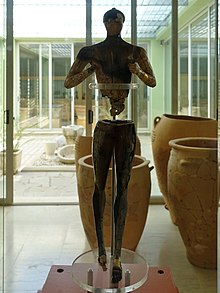Palaikastro Kouros
Appearance

The Palaikastro Kouros is a chryselephantine statuette of a male (kouros) found in the modern-day town of Palaikastro on the Greek island of Crete. It has been dated to the Late Minoan period (15th century BC) during the Bronze Age. It is currently on display in the Archaeological Museum of Siteia. Standing roughly 50 cm (19.5 in) tall, its large size and the value of its materials indicate that it possessed value as a cult image. The vast majority of its body (torso, legs, arms, and feet) is made of ivory covered with gold foil. Its head differs slightly in make from the body, crafted from gray-green serpentinite with rock-crystal eyes and detailed further with ivory.
References
- Lapatin, Kenneth D. S., J. A. Macgillivray, J. M. Driessen, L. H. Sackett, C. V. Crowther, P. Harrison, S. A. Hemingway, R. B. Koehl, M. S. Moak, A. Moraitou, J. Musgrave, A. Nikakis, S. E. Thorne, and J. Weingarten. "The Palaikastro Kouros: A Minoan Chryselephantine Statuette and Its Aegean Bronze Age Context." American Journal of Archaeology 106.2 (2002):
- Mac Gillivray J.A., Sackett L.H., Driessen J.M., "The Palaikastro Kouros, a Minoan Chryselephantine Statuette and its Aegean Bronze Age Context", BSA Studies, (1999)
- The Palaikastro Kouros at the Odysseus portal of the Hellenic Ministry of Culture
